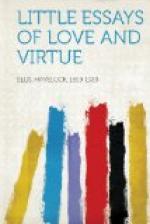[8] Mrs. Havelock Ellis, James Hinton: A Sketch, Ch. IV.
[9] Olive Schreiner in a personal letter.
[10] Mrs. Havelock Ellis, James Hinton, p. 180.
I have mentioned how the Church—in part influenced by that clinging to primitive conceptions which always marks religions and in part by its ancient traditions of asceticism—tended to insist mainly, if not exclusively, on the animal object of marriage. It sought to reduce sex to a minimum because the pagans magnified sex; it banned pleasure because the Christian’s path on earth was the way of the Cross; and even if theologians accepted the idea of a “Sacrament of Nature” they could only allow it to operate when the active interference of the priest was impossible, though it must in justice be said that, before the Council of Trent, the Western Church recognised that the sacrament of marriage was effected entirely by the act of the two celebrants themselves and not by the priest. Gradually, however, a more reasonable and humane opinion crept into the Church. Intercourse outside the animal end of marriage was indeed a sin, but it became merely a venial sin. The great influence of St. Augustine was on the side of allowing much freedom to intercourse outside the aim of procreation. At the Reformation, John a Lasco, a Catholic Bishop who became a Protestant and settled in England, laid it down, following various earlier theologians, that the object of marriage, besides offspring, was to serve as a “sacrament of consolation” to the united couple, and that view was more or less accepted by the founders of the Protestant churches. It is the generally accepted Protestant view to-day.[11] The importance of the spiritual end of intercourse in marriage, alike for the higher development of each member of the couple and for the intimacy and stability of their union, is still more emphatically set forth by the more advanced thinkers of to-day.
[11] It is well set forth by the Rev. H. Northcote in his excellent book, Christianity and Sex Problems.




